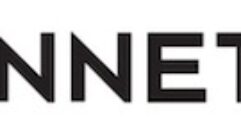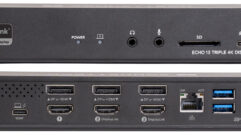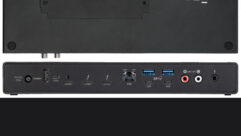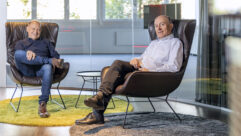French Connections
Apr 1, 2001 12:00 PM,
Alex Artaud
Fontana created a common library of sounds to be used for allstations… all working together to create a distinct, Lyonnaissound.
“The task of acoustic art and design is to fundamentallychallenge the historical definitions of noise.” — BillFontana
SINCE 1974, BILL Fontana has been creating works of sound artthroughout the world. An early interest in the inherent musicalityof the sounds around us led to his present-day specialty incapturing and presenting acoustic sounds in entirely differentlocations. Examples of his many works include transporting thesounds of Niagara Falls to the outside wall of the Whitney Museumin New York, creating an “acoustic map” of the city ofVenice and recently completing a project commissioned by the cityof Lyon, France.
“The most basic assumption I am making is that at anygiven moment there will be something meaningful to hear.”
In his essay, “Sound as Virtual Image,” Fontanadescribes his work: “Most of my projects have been created inurban public space, where an architectural situation is used as thephysical and visual focal point of sounds that are relocated tothese situations. Loudspeakers are normally mounted on the exteriorof a building or a monument and are used to deconstruct andtransform the situation by creating a virtual transparent realityof sound. Sound sculptures placed on the exterior of a buildingtake on the visual aspects of the architecture and the urbanlandscape in which they are placed and create a perceptual tensionbetween what you see and what you hear…The most basicassumption I am making is that at any given moment there will besomething meaningful to hear. I am, in fact, assuming that music— in the sense of meaningful sound patterns — is anatural process that is going on constantly.”
In the summer of 1999, Fontana was invited by SYTRAL, a Frenchgovernment organization that oversees public art, to submit adesign for a sound art installation for 18 stations along Line 1 ofthe Lyon Tramway. The proposal presented by Fontana, andsubsequently accepted that November, combined recorded and livesounds that would be fed to each station via fiber-optic cable. Thecompleted installation would also serve as a conduit for infrequentpublic service announcements but would primarily provide asoundscape of sounds collected both within and on the outskirts ofthe city of Lyon. Unlike Fontana’s previous works, this would be apermanent, public artwork and would require durable and reliableequipment needing little service over many years.
THE SOUNDSCAPE’S “CANVAS”
Line 1 of the Tramway runs 8 kilometers through the older partsof the city, ending at the University of Lyon. The stations, whichcould best be described as sleek, upscale bus shelters, are fairlyarchitecturally transparent, with see-through surfaces supported byrelatively spare frames. “The tram station is in such anintimate environment that the sidewalk literally runs through andbecomes part of the station,” says Fontana. Many differentpeople, therefore, will have a cumulative exposure to the soundartwork, whether they ride the tram every day or walk along thesidewalk regularly. “This is a special impact that I’mcurious about,” he adds. “It’s very different thandoing a similar installation for a museum.”
Given the intimacy of the surroundings, there were inherentrisks involved. “This is a permanent work in a public spaceclose to places where people are living and working. You have to bevery careful in an artwork like this not to create a noise problem.You need to manage where the sound is going to be heard or it’llbecome irritating to people. So, it became a challenge to get thesound I wanted, in the zone I wanted, without beingintrusive.”
This last issue was exacerbated by the size limitations posed bythe tram station structure. The space would only permit a speakerenclosure roughly the size of a 4-inch cube. Fontana had to find aloudspeaker that would provide 90dB SPL at 3 feet and very narrowcoverage so as not to present a noise risk. Finding no commerciallyavailable options that satisfied his requirements, he approachedMeyer Sound with his dilemma. The result of this meeting was thecreation of the new MM-4 speaker and its companion MM-4 CEU controlelectronics unit. For Fontana, being able to work with Meyer Soundearly in the process made all the difference for this piece.“Without a loudspeaker that could articulate what I wantedacoustically in this situation, I couldn’t have realized myintentions. Their speakers have a clarity and naturalness ofsound.” (See Sidebar.)
GATHERING SOUNDS
During the course of the year, Fontana visited Lyon severaltimes to capture ambient sounds of the city and its surroundings.Travelling with a portable Sony DAT, Sanken stereo microphones, ahydrophone (to record the Rhone River), B&K vibration sensors(accelerometers) and omni-directional microphones, Fontana createda common library of sounds to be used for all stations. Among thesewere children playing games with metal balls, accordion players,voices in the markets, footsteps along pedestrian bridges, birds onthe outskirts of town, and the nearby Rhone — all workingtogether to create a distinct, Lyonnais sound.
After his trips, Fontana returned to his home studio inCalifornia and transferred, compiled and edited material on aMacintosh G4 running Bias’ Peak. He then created eighteen 90-minutemono submixes using Digidesign’s ProTools. All sounds were archivedat 16-bit, 48 kHz, and saved as AIFF files. To deliver the soundsto each station, Fontana selected Richmond Sound Designs’ AudioBox,a digital matrix mixer that provides eight analog inputs, 16 analogoutputs, plus 16 digital disk playback channels. It also includes a9.1GB internal hard disk that provides over 24 hours of audioplayback storage. Any combination of all 16 playback channels canplay simultaneously from any of the stored audio. This is a veryflexible system, allowing independent audio level control at eachof its 256 matrix crosspoints. One can also program crossfadesbetween different matrix configurations, as well as performmultiband EQ and audio delay.
HARDWARE AND SOFTWARE
Using Third Monk’s ABC File Loader and ABControl software on aMacintosh G3, Fontana transferred his submixes into the AudioBoxvia SCSI and programmed sequences that would go to each station.Each of the 90-minute segments was programmed to loop around and/orcrossfade into another 90-minute submix — all to be randomlydetermined and managed by the AudioBox. Integration into the mix ofthe five live locations was aided by Audiobox’s programmablediffusion generator, which allowed Fontana to program crossfades,the velocity of transmission and the movement of the live sound mixto each of the stations.
The unit’s combination of programmable features (including theability to randomly mix program segments) meant that Fontana couldexpect 16 unique mixes at each output. Given that there were 18stations equipped to receive audio feeds, the only limitation wasthe unit’s limit of 16 outputs. Even with trade-off of replicatingmixes for two of the tram stations, Fontana was pleased with theunit: “The AudioBox is a very stable matrix mixer, and onceprogrammed, you can disconnect the computer and it will run on itsown without the need for an external controller.” In fact,once Fontana completed programming, all the AudioBox needed was anautomated command at 7 a.m. to switch it on, and another at 10 p.m.to switch it off. This was a nice way of keeping people fromtampering with it, too.
In the event that an announcement needed to be transmitted tothe tram stations, a source signal can throw a switch that sends aninternal MIDI message to the Audiobox to shift it to a differentphase of the program. This allows the paging to go forward andautomatically shift back and crossfade into the main program oncethe announcement is completed.
LIVE SOUNDS
For the live portion of the installation, Fontana scoutedlocations for sounds to be transmitted to each station. Livetransmission of sound is a signature element of most of Fontana’swork, and at Lyon he selected five locations to provide elementsfor the soundscape. Prominent are the sounds of bells from clocktowers such as the Cathédrale St. Jean, an astrological clockand historical landmark; the sound of clocks from the Basilica ofFourviere; and the Carrillon de l’Hôtel de Ville, whose clockbells register an altogether different time (a humorous,serendipitous accident for a project like this). Fontana also chosethe Brasserie Georges, a famous restaurant that he selected for itsbeautiful acoustics. Last, he placed a microphone at the Gare dePerrache, or Perrache Station. Fontana was drawn to the space’sacoustic signature, with the sounds of TDG long-distance trainscoming and going and periodic announcements over the intercom.Perrache Station also became a convenient location to house theAudioBox.
Fontana had considered different ways of transmitting signalsfrom each location but decided in the end that it was best to gowith UHF. After reviewing options for microphones and transmitters,he chose Senn-heiser’s MKH2 microphones and paired them with250-milliwatt Sennheiser SK250 UHF transmitters, which are roughlyfive times as powerful as most standard UHF transmitters. Tofurther enhance the system, he employed directional antennas andantennas with gain. Amazingly, all the live microphone locationswere within a 1Km line of sight from the main SK250 receiver on topof the Perrache station — well within range for goodreception.
UP AND RUNNING
Semaly, a French engineering firm contracted by the city ofLyon, oversees the entire operation of the Lyon Tramway. Prior toSYTRAL’s selection of Fontana’s proposal, Semaly, under thedirection of chief engineer Pierre Geneste, had installed aconfigurable Siemens routing system that included room for sound,video and data cards, all multiplexed over a multimode, fiber-opticnetwork. The flexibility of this system made the integration ofFontana’s work a lot smoother. All the stations were connected tothe AudioBox station (Perrache) via the Siemens routing system, andsoundcards were inserted at each tramway station where equipmentwas present. Typically, a station should include one TOApreamplifier, a 600W dual mono power amplifier and four MM-4loudspeakers. While Semaly provided fiber-optic lines to eachlocation, Joël Clarenne of Roiret Enterprises in Lyon handledthe installation of all the equipment under the supervision of BillFontana.
Once installed, the system levels had to be set for eachstation. “The only way of controlling the AudioBox was from acomputer in Perrache,” said Fontana. “So, I would havesomebody go to each station in succession, measure the SPL and callme. It was very time consuming because there were 18 stations. Andbecause I’m working with stored and live sounds, it’s not entirelypredictable what we’ll get, so we have to live within a certainrange.”
CONCLUSION
Bill Fontana’s installation in Lyon represents a milestone forpublic sound art, and perhaps for Bill Fontana’s work as well. Yetsome issues still persist for Fontana after several years ofworking in sound art.
“There is a very simple paradox in my work, and I’msurprised this is still an issue after all these years. I begancalling my work ‘sound sculptures’ 25 years ago, and Ialways defined it as using sound as a sculptural medium —there was no object involved. Simply, I saw it as the ability ofsound to invisibly transform visual space. That was a verydifficult idea for someone to grasp in 1974; and today, it’s stillmore inconceivable in the art world than I would have anticipated.People still expect objects with things that make sounds. Theystill want to see something connected to it.
“I consider the visual element to be the space that thesound is in, and the mind space that it creates. The language ofsound that I am working with is from the natural world. It’s alanguage that makes you want to see.”
For more on Bill Fontana’s work, visit his Web site www.resoundings.org.
Alex Artaud is a sound engineer and writer living inOakland, California.
Technical Spotlight: Meyer Sound MM-4 Loudspeaker and MM-4CEUProcessor
WHEN BILL FONTANA APPROACHED MEYER SOUND, HE couldn’t have knownthat his project would spawn two new products.
The MM-4 consists of a single, 4-inch-diameter cone transducerwith a 25-watt, 16-ohm, long-excursion voice coil with air-cooledceramic magnet structure. It’s mounted in a sealed,4×4×4.21-inch aluminum enclosure that provides heatsinking for the transducer’s voice coil and weighs just under 4pounds. The speaker provides 90° nominal coverage with acontinuous SPL of 100 dB at 1 meter, and peak output of 110 dB whenused with the Meyer Sound MM-4CEU controller. The MM-4 usesPhoenix-type sealed and keyed connectors and is covered with aperforated steel grille. It has a frequency response of 125 Hz to15 kHz, ±4dB. The MM-4CEU is a single-rackspace processorproviding two separate channels with frequency responseoptimization filters, phase alignment and protection limitersdesigned specifically for the MM-4 loudspeaker system. The MM-4CEUprovides RMS and Peak limiting to the audio signal feeding thepower amplifier when activated by Meyer Sound’s proprietarySpeakerSense™ driver protectioncircuit. A recessed, front-panel, first-order, 160Hz high-passfilter switch is provided for each channel and allows frequencycompensation to be applied when an optional subwoofer is employedor for architectural or acoustic boundary conditions.
FOR MORE INFORMATION
ABControl
www.abcontrol.com
Circle 293 on Reader Service Card
B&K
www.bkcomp.com
Circle 294 on Reader Service Card
Bias
www.bias-inc.com
Circle 295 on Reader Service Card
Digidesign
www.digidesign.com
Circle 296 on Reader Service Card
Macintosh
www.mac.com
Circle 297 on Reader Service Card
Meyer Sound
www.meyersound.com
Circle 298 on Reader Service Card
Richmond Sound Design
www.richmondsounddesign.com
Circle 299 on Reader Service Card
Sanken
rtg.ch/sanken.htm
Circle 300 on Reader Service Card
Sennheiser
www.sennheiser.com
Circle 301 on Reader Service Card
Siemens
www.siemens.com
Circle 302 on Reader Service Card
Sony
www.sony.com
Circle 303 on Reader Service Card
Third Monk
www.thirdmonk.com
Circle 304 on Reader Service Card
TOA
www.toaelectronics.com
Circle 305 on Reader Service Card










